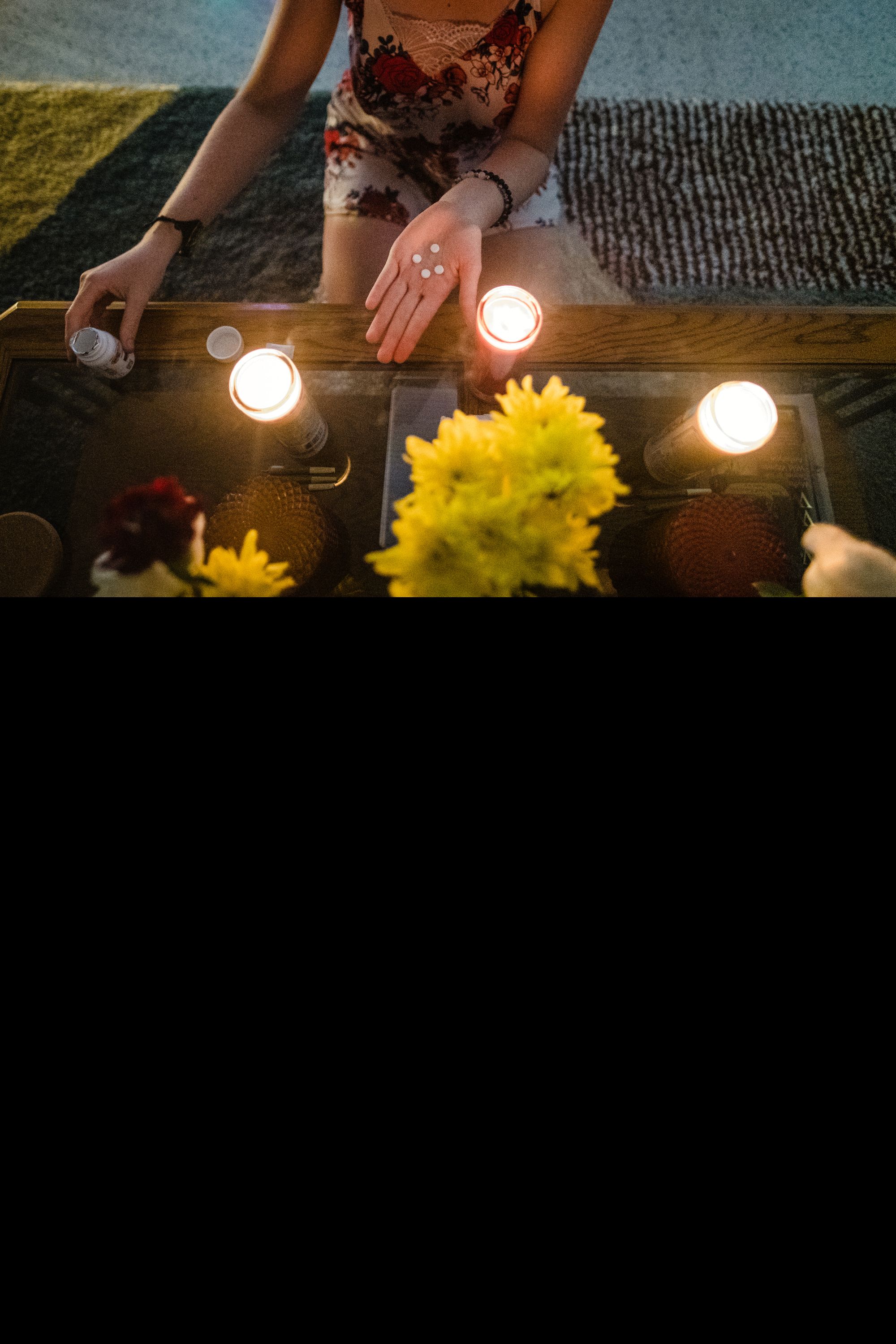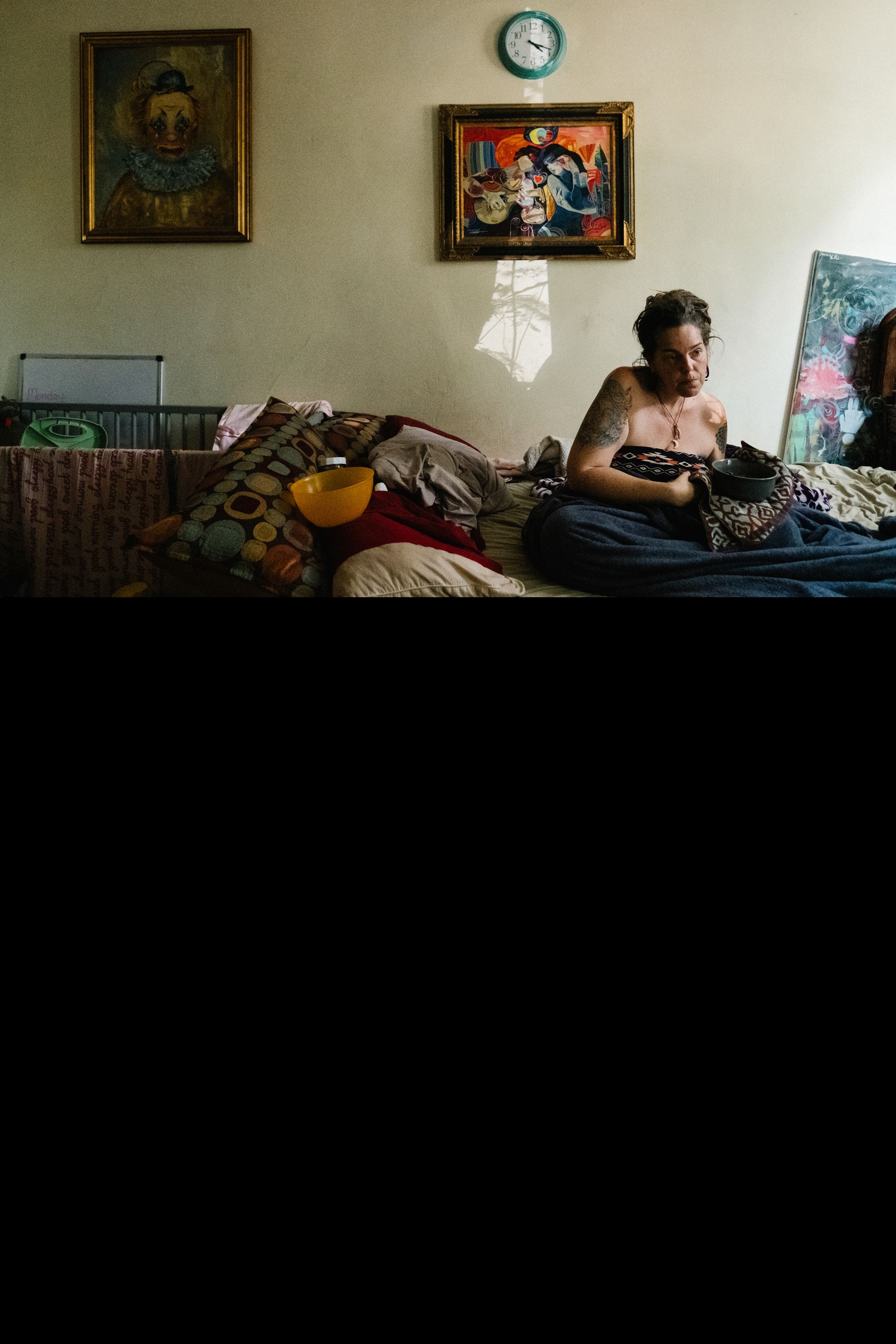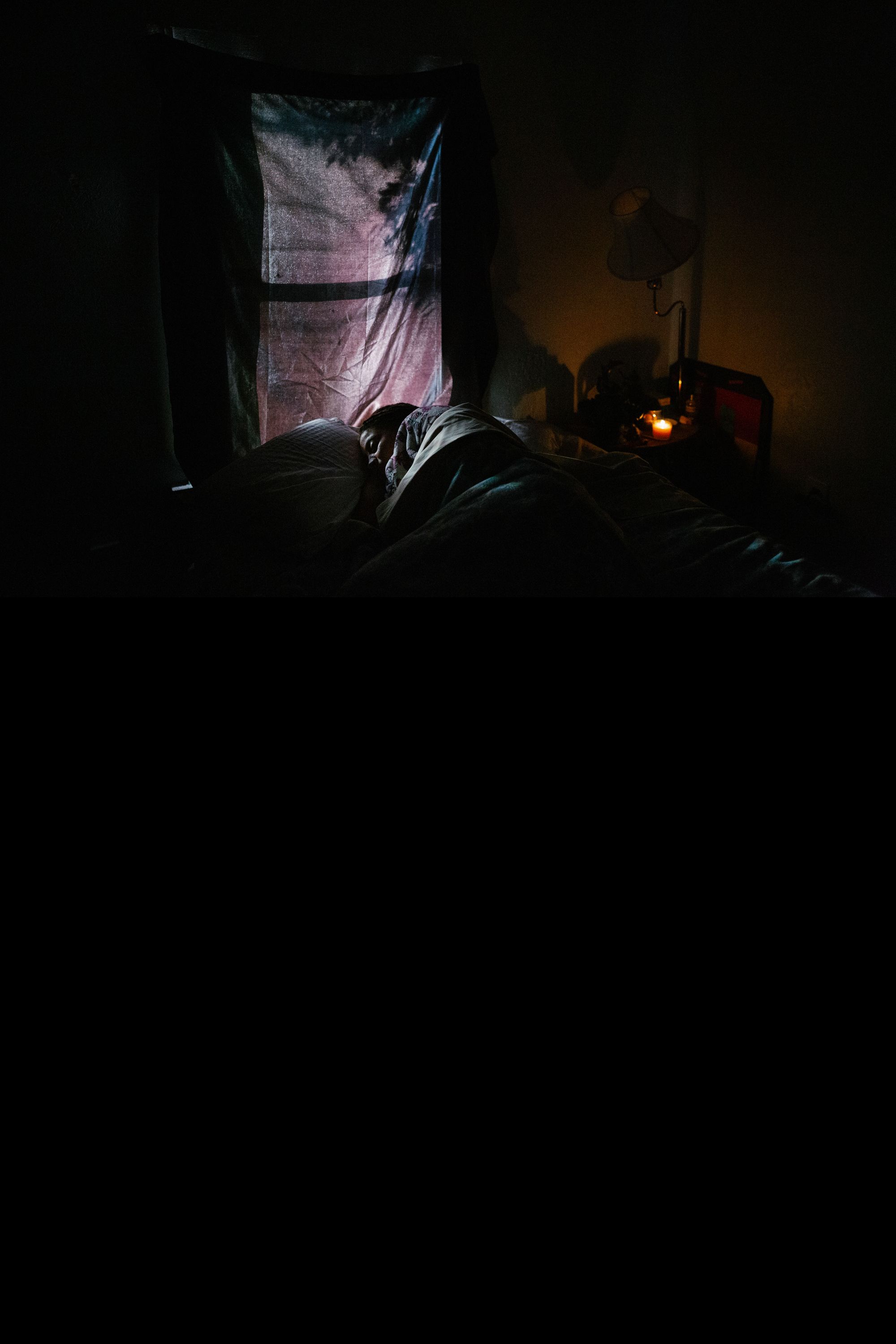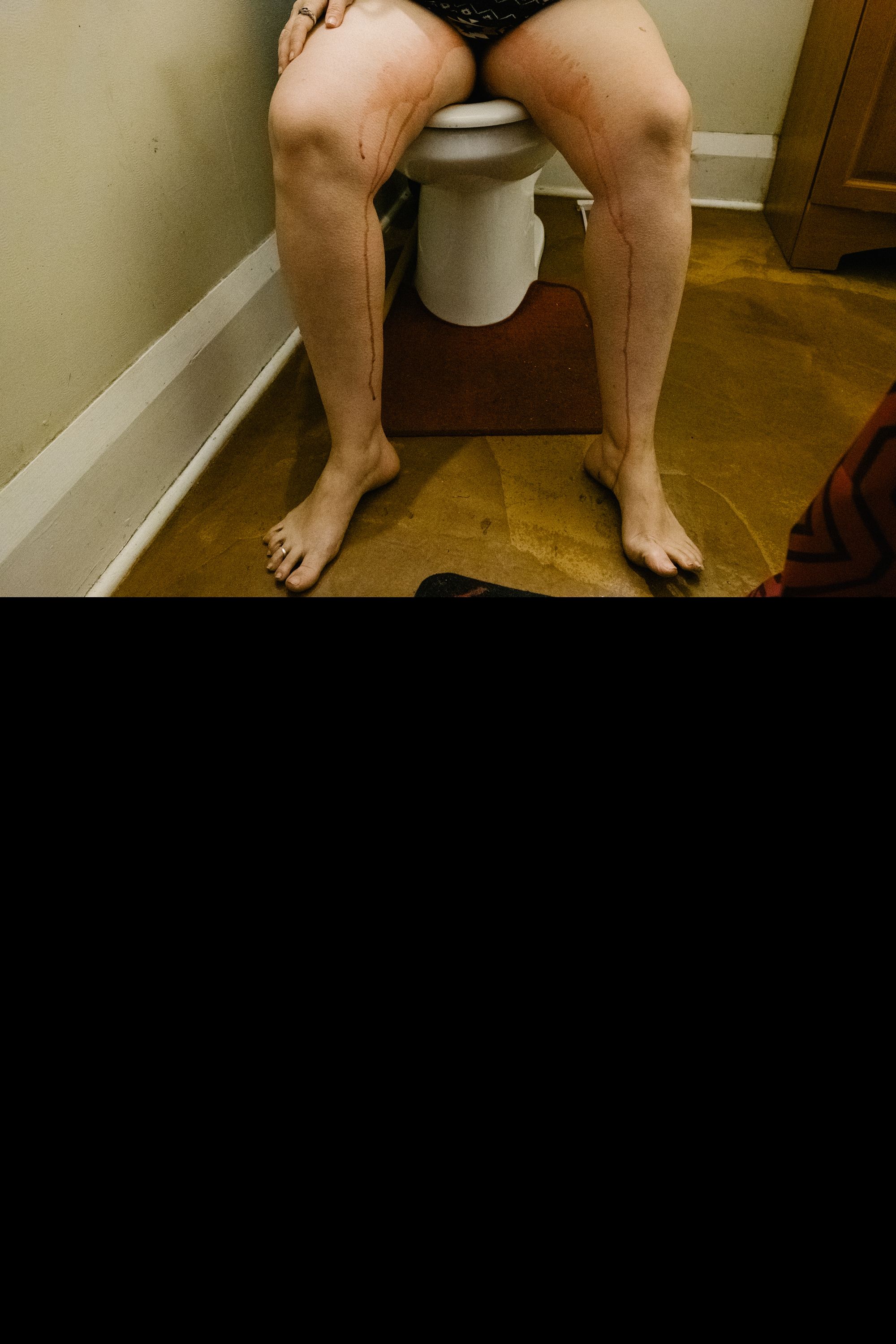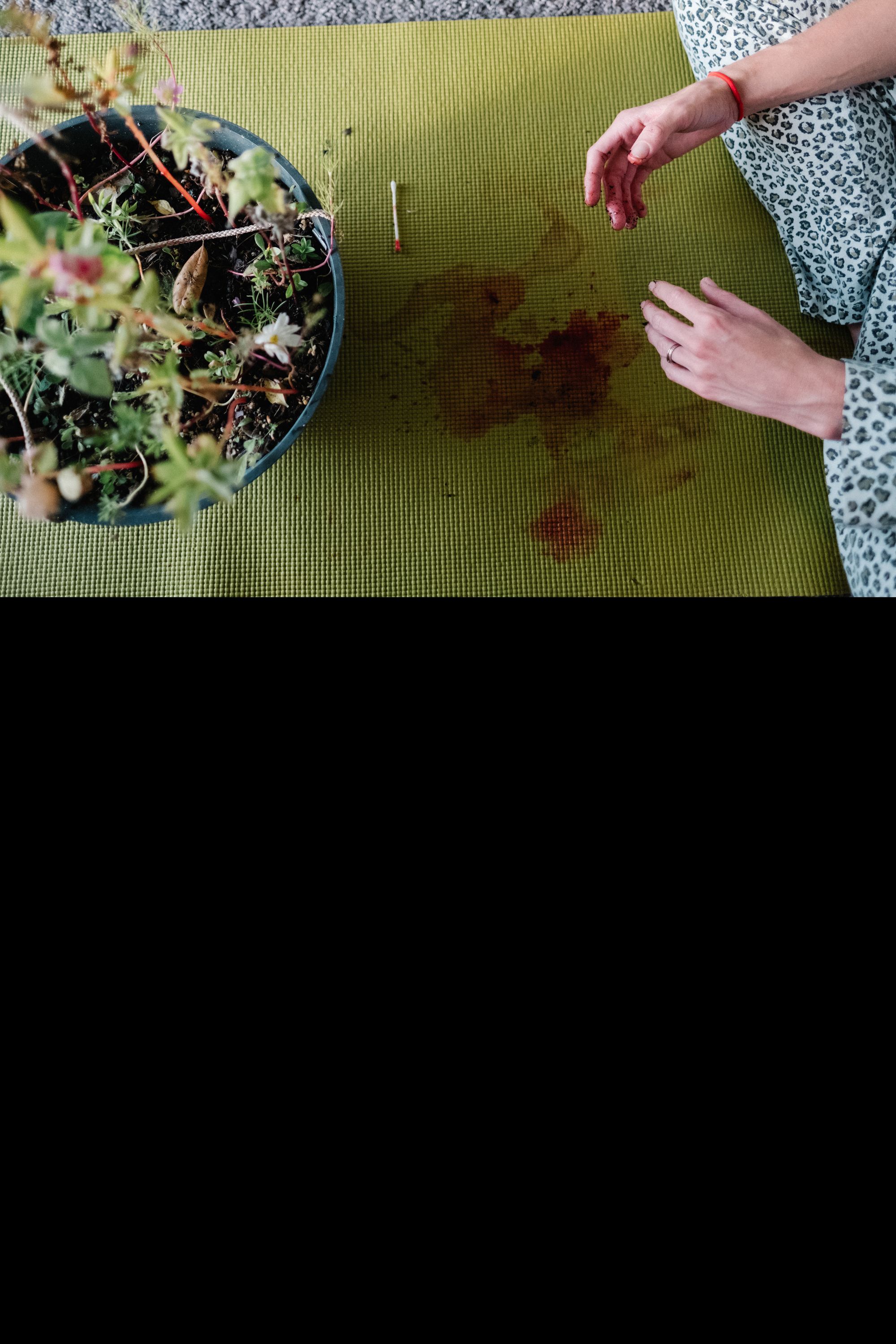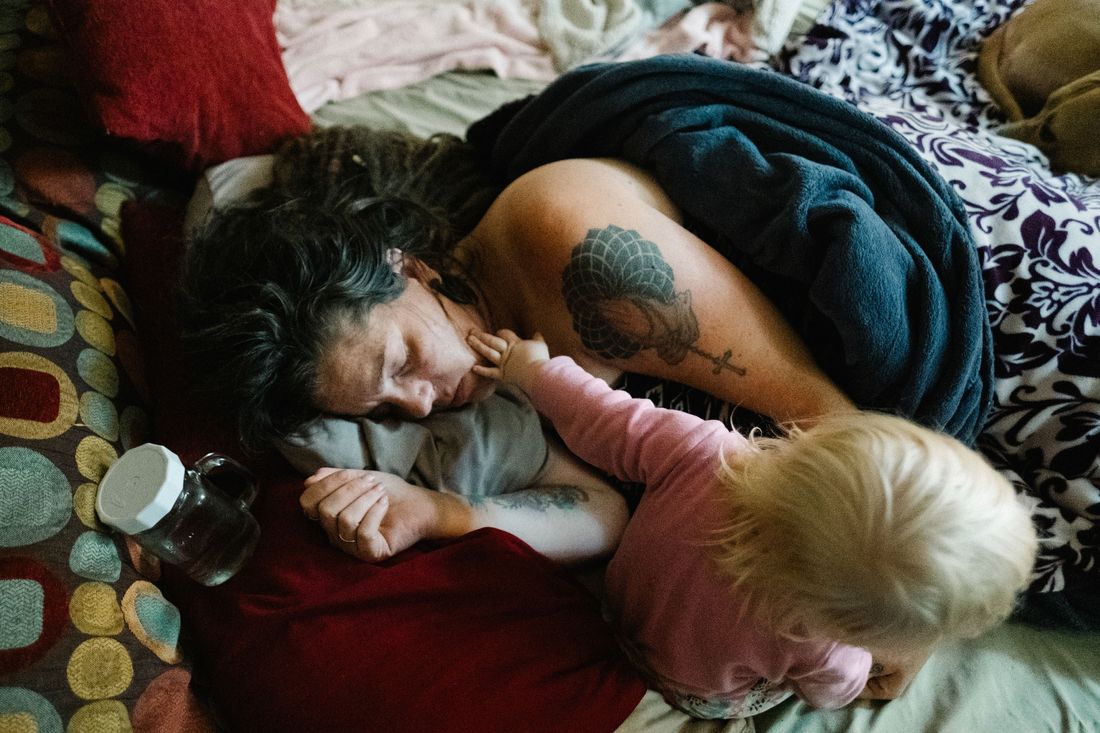
The visual language of abortion is still often defined by coat hangers and graphic close-ups of fetal remains, tropes that don’t reflect the reality of contemporary abortion care. Over half of abortions in the United States are administered medically, with pills that can be taken from the comfort of home. As full-spectrum doulas — who support all outcomes of pregnancy, including abortion — Heather and Sarah noticed that these misperceptions created anxiety and confusion for the people they supported. Determined to show the reality of the experience, Heather and Sarah began a project to photograph their clients as they have their abortions, while providing doula support in the process. Since 2019, the two have documented seven abortions around the country, collecting the images in zines that they distribute through their website.
Heather: In 2019, shortly after Sarah and I met at a training event, I got unexpectedly pregnant. My partner and I knew right away that we wanted to have an abortion. Even though I was training as a full-spectrum doula, I wasn’t prepared for my abortion. It would have helped me so much to actually see what people actually go through. I was hit with how similar having an abortion is to giving birth to a live baby. I felt like I was having contractions just like I did giving birth. I had my abortion in a hotel room with Sarah and another friend, who was also a doula. Sarah took pictures with her cell phone, which was really powerful to me, because as a birth photographer, I know how amazing it is to have images of those experiences in your life to not only process, but to share your story.
After my abortion, Sarah and I knew that we wanted to do something together that showed what abortion actually looks like. We wanted to not only destigmatize it, but to demystify it and let people know what they could expect for their abortion, so we founded the Abortion Project.
Sarah: We get a lot of referrals from people who I have supported in the past and from local abortion funds. Usually when people find out they’re unexpectedly pregnant, they kind of panic and don’t know what to do. When people think about accessing abortion, they think it’s just a quick trip to a clinic, but it’s so much more. As full-spectrum doulas, we’re not just there for emotional and physical support, but really helping people with navigating the system itself, connecting them with clinics and abortion funds. When you’re stressed out, it’s so hard to make decisions, and it’s really important to have someone by your side who has experience to walk you through your options.
After someone has made their clinic appointment, we start talking about a care plan. We do our best to prepare them beforehand, making sure that they have enough food in their house or helping them plan child care if needed. Whether it’s a live birth, abortion, or a miscarriage, we’re asking a lot of the same questions. Every experience is so incredibly individual, and there’s so many different feelings that somebody can have. Someone who is having a miscarriage could feel relief, or someone who’s having an abortion could be feeling an incredible sadness.
Heather: There is nuance to following the language each person uses, whether they’re calling the pregnancy a baby or “the pregnancy” or by a name. There is a process to feeling out each person that isn’t necessarily asking questions, but taking their lead and following. For an abortion specifically, we’ll ask who they want to be present, what they want to call the pregnancy, and what they want to do before and after the abortion, ritual-wise. We also ask how they manage stress and pain in their day-to-day life, because that can be really telling of how they’re going to want to be cared for during their abortion experience.
Heather: Sarah takes the lead doula role while I am photographing a lot during the experiences, but I try to jump in as much as I can. It’s really amazing working with two doulas because we pick up on things the other may have missed.
Sarah: Mifepristone, the medication that ends the pregnancy, is given in the clinic. In some states, they have to physically watch you take it. You’re sent home with misoprostol to take later, which expels the pregnancy, and that’s what we are supporting and documenting.
Heather: Misoprostol is taken by dissolving the pills in your cheek or under your tongue so that you hopefully don’t get as many side effects, like diarrhea and nausea, as you would from swallowing it. That way it’s absorbed directly into the bloodstream, bypassing the stomach.
Heather: It takes 20 to 30 minutes for the medication to dissolve. Here, a participant checks the progress of the four misoprostol pills dissolving under her tongue.
Heather: People misunderstand the need for medical abortions. They think that they’re all dire situations and that’s not the case. Sometimes it’s just an accidental pregnancy, or the birth control failed.
Maybe it’s just bad timing. Those are all valid reasons to end a pregnancy.
Heather: We spend a lot of time in the beginning getting to know the participants. We’ve gardened and watched TV shows with them, waiting for the medication to take effect. This participant read our tarot while using a TENS unit, which sends electrical signals through the body, to distract from the pain.
Heather: People gloss over the fact that a lot of people having abortions are parents already. Not everyone is able to find child care during their abortion. Even though this participant was struggling with nausea and cramping, she was incredibly present with her daughter, who comforted her throughout the day.
Heather: Sometimes when we’re with people and they take the medication, things don’t start right away. We try to stay at least 12 hours, but sometimes they just want to go to bed. If they start bleeding a couple days later, we can’t always make it back, so we support them virtually, which happened with this participant.
Heather: With doula training, they’ll tell you the mechanics of something, but they won’t dive into the emotional complexities. This woman dropped to her knees in shock when her pregnancy was expelled. She began praying and asking us for forgiveness for her emotional state while Sarah comforted her.
Sarah: When you are giving birth, there is a rhythm to the contractions, but when you take this medication for an abortion, it’s essentially like one long contraction. Instead of getting breaks in between, it’s one consistent, really uncomfortable experience until it finally moves through your cervix.
Miscarriage and abortion are essentially identical — it’s one physiological process.
Heather: There can be a lot of bleeding, which sometimes scares people. But it’s normal. It’s heavier than a period, but it’s normal for an abortion.
Heather: There is a huge variation of normal for medical abortions, just like birth. A few hours after this participant had taken the medication, she was cramping a lot, but not bleeding. We suggested she take a bath to help relieve the pain.
Sarah: After the bath, this client was walking to her closet when the pregnancy fell out of her body unexpectedly. She lost a blood clot, and then the pregnancy. She terminated at eight weeks.
Heather: Sometimes there are complications. A few days after her medical abortion, this participant had a fever and some pain, so we knew that the abortion probably wasn’t complete.
Her health-care provider sent her to the hospital, and I went with her for support. She had to have a dilation and curettage procedure to make sure that the pregnancy was removed fully.
Sarah: It’s not uncommon to hold a ceremony for the pregnancy after the abortion is finished. This participant chose to bury the pregnancy in a pot of wildflowers that her kids had sprouted and cared for, watering them every day.
Heather: We are still figuring out how to navigate a post-Roe world. Safety is the most important, for us as a nonprofit, but also for our participants. We want to be able to spread these stories as far and wide as we can, but it’s scary when you come up against opposition.
If anything, it ignites that fire under us to keep going.
Sarah: Mifepristone, the medication that ends the pregnancy, is given in the clinic. In some states, they have to physically watch you take it. You’re sent home with misoprostol to take later, which expels the pregnancy, and that’s what we are supporting and documenting.
Heather: Misoprostol is taken by dissolving the pills in your cheek or under your tongue so that you hopefully don’t get as many side effects, like diarrhea and nausea, as you would from swallowing it. That way it’s absorbed directly into the bloodstream, bypassing the stomach.
Heather: It takes 20 to 30 minutes for the medication to dissolve. Here, a participant checks the progress of the four misoprostol pills dissolving under her tongue.
Heather: People misunderstand the need for medical abortions. They think that they’re all dire situations and that’s not the case. Sometimes it’s just an accidental pregnancy, or the birth control failed.
Maybe it’s just bad timing. Those are all valid reasons to end a pregnancy.
Heather: We spend a lot of time in the beginning getting to know the participants. We’ve gardened and watched TV shows with them, waiting for the medication to take effect. This participant read our tarot while using a TENS unit, which sends electrical signals through the body, to distract from the pain.
Heather: People gloss over the fact that a lot of people having abortions are parents already. Not everyone is able to find child care during their abortion. Even though this participant was struggling with nausea and cramping, she was incredibly present with her daughter, who comforted her throughout the day.
Heather: Sometimes when we’re with people and they take the medication, things don’t start right away. We try to stay at least 12 hours, but sometimes they just want to go to bed. If they start bleeding a couple days later, we can’t always make it back, so we support them virtually, which happened with this participant.
Heather: With doula training, they’ll tell you the mechanics of something, but they won’t dive into the emotional complexities. This woman dropped to her knees in shock when her pregnancy was expelled. She began praying and asking us for forgiveness for her emotional state while Sarah comforted her.
Sarah: When you are giving birth, there is a rhythm to the contractions, but when you take this medication for an abortion, it’s essentially like one long contraction. Instead of getting breaks in between, it’s one consistent, really uncomfortable experience until it finally moves through your cervix.
Miscarriage and abortion are essentially identical — it’s one physiological process.
Heather: There can be a lot of bleeding, which sometimes scares people. But it’s normal. It’s heavier than a period, but it’s normal for an abortion.
Heather: There is a huge variation of normal for medical abortions, just like birth. A few hours after this participant had taken the medication, she was cramping a lot, but not bleeding. We suggested she take a bath to help relieve the pain.
Sarah: After the bath, this client was walking to her closet when the pregnancy fell out of her body unexpectedly. She lost a blood clot, and then the pregnancy. She terminated at eight weeks.
Heather: Sometimes there are complications. A few days after her medical abortion, this participant had a fever and some pain, so we knew that the abortion probably wasn’t complete.
Her health-care provider sent her to the hospital, and I went with her for support. She had to have a dilation and curettage procedure to make sure that the pregnancy was removed fully.
Sarah: It’s not uncommon to hold a ceremony for the pregnancy after the abortion is finished. This participant chose to bury the pregnancy in a pot of wildflowers that her kids had sprouted and cared for, watering them every day.
Heather: We are still figuring out how to navigate a post-Roe world. Safety is the most important, for us as a nonprofit, but also for our participants. We want to be able to spread these stories as far and wide as we can, but it’s scary when you come up against opposition.
If anything, it ignites that fire under us to keep going.


